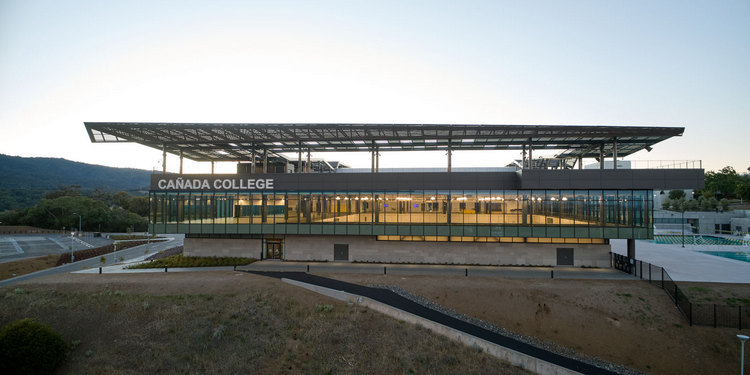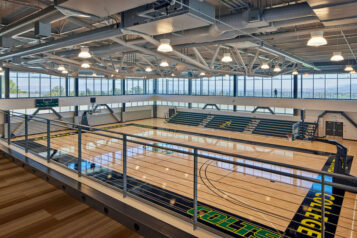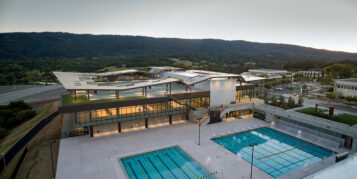
Construction is complete on the new Kinesiology and Wellness building on San Mateo County Community College District’s Cañada College campus in Redwood City, California.
The 115,000-square-foot teaching and learning building is positioned above the Bay Area Peninsula’s Interstate 280 and was delivered through a progressive Design-Build contract that included Blach Construction and ELS Architecture and Urban Design. Rounding out the picturesque campus, the leading-edge structure enables the college to enhance academic offerings and expand its athletics department, while serving as an important community resource as well.
A focal point on Cañada’s campus, the new Kinesiology and Wellness building replaces the school’s outdated concrete gymnasium erected in 1967, never fully completed and lacked critical features, most notably the initially planned pool and an HVAC system. It is set amidst rolling hills in a Wildland Urban Interface, two distinct building challenges that were alleviated by the project team’s collaborative relationship and ability to deliver innovative solutions. The result is a new facility targeting LEED Gold certification with many unique and distinguished features, including more than 60 different exterior skin conditions, an array of workout, gymnasium and support spaces, two competition-sized pools, an activated roof with track, pickle ball courts and yoga studio, a hall of fame wall that pays homage to Cañada’s elite and inspiring student athletes and an expanded parking lot with 400 additional spaces.
Aesthetically, the Kinesiology and Wellness building serves as a landmark for both Cañada and the San Francisco Bay Area mid-Peninsula region. The 55-foot-tall building can be seen easily from the busy freeway below. Its second floor, which is made entirely of glass, reflects the sun and surrounding terrain, while its translucent spine evokes a lit lantern at night. The roofline, defined by an innovative canopy, mimics the rolling hills. These crown the activated roof, which has been constructed over open gym space below and proved to be a great challenge for the team.
A significant advantage of progressive Design-Build delivery included the ability to identify challenges with fabricating, assembling and erecting the rooftop canopy in the early stages of design. The project team leveraged its collective expertise and closely coordinated with the structural steel contractor and engineering teams to devise an inventive and efficient strategy. The teaming efforts led to a componentized design that could be assembled offsite, enabling safer working and installation environments and saving the district more than $2 million. Additionally, the canopy reduces the energy consumption of the building by decreasing the solar heat gain to its second floor and increasing shading to the roof.
Additionally, as a result of the progressive Design-Build collaboration, Blach was able to self-perform a great deal of the concrete work, most notably the retaining walls, exposed concrete walls, foundation/footings and concrete decks.
Other project partners included construction manager Swinerton, CPI Daylighting Inc., Forell/Elsesser, SWA, Robert A. Bothman, AGC, Intermountain Electric, KDS Plumbing, RCM Fire Protection, Glazier Steel, B.T. Mancini and Royal Glass.





 Join our thriving community of 70,000+ superintendents and trade professionals on LinkedIn!
Join our thriving community of 70,000+ superintendents and trade professionals on LinkedIn! Search our job board for your next opportunity, or post an opening within your company.
Search our job board for your next opportunity, or post an opening within your company. Subscribe to our monthly
Construction Superintendent eNewsletter and stay current.
Subscribe to our monthly
Construction Superintendent eNewsletter and stay current.